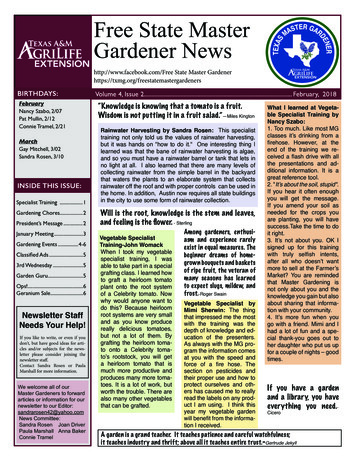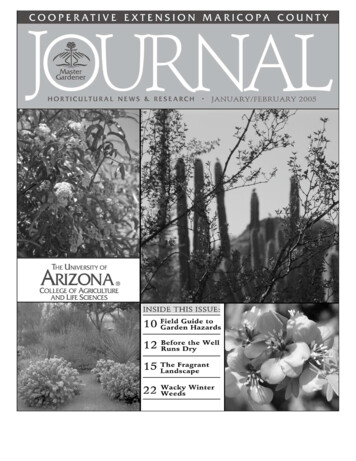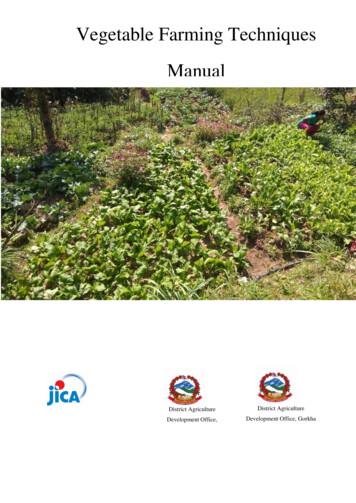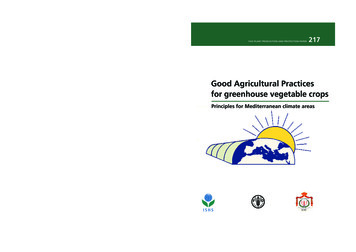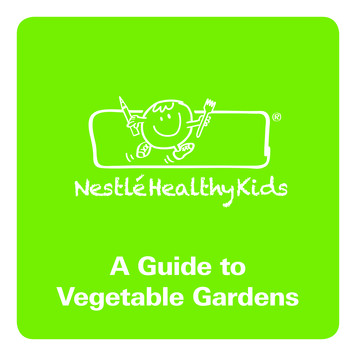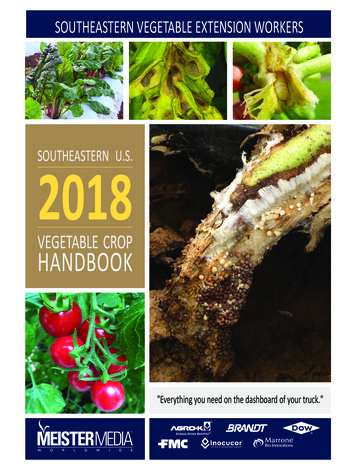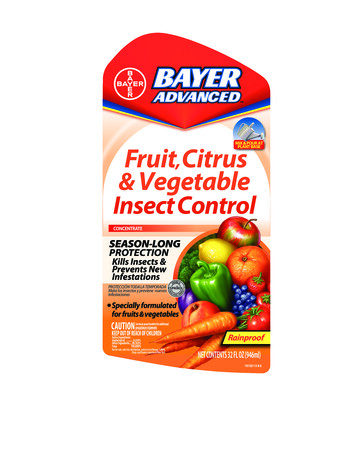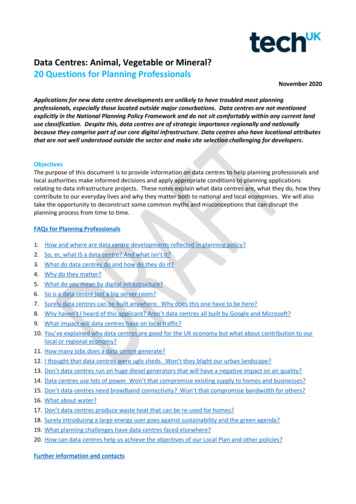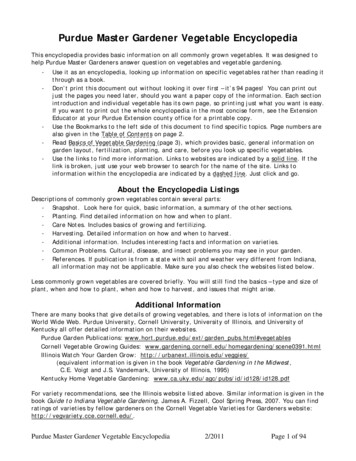
Transcription
Purdue Master Gardener Vegetable EncyclopediaThis encyclopedia provides basic information on all commonly grown vegetables. It was designed tohelp Purdue Master Gardeners answer question on vegetables and vegetable gardening.--Use it as an encyclopedia, looking up information on specific vegetables rather than reading itthrough as a book.Don’t print this document out without looking it over first – it’s 94 pages! You can print outjust the pages you need later, should you want a paper copy of the information. Each sectionintroduction and individual vegetable has its own page, so printing just what you want is easy.If you want to print out the whole encyclopedia in the most concise form, see the ExtensionEducator at your Purdue Extension county office for a printable copy.Use the Bookmarks to the left side of this document to find specific topics. Page numbers arealso given in the Table of Contents on page 2.Read Basics of Vegetable Gardening (page 3), which provides basic, general information ongarden layout, fertilization, planting, and care, before you look up specific vegetables.Use the links to find more information. Links to websites are indicated by a solid line. If thelink is broken, just use your web browser to search for the name of the site. Links toinformation within the encyclopedia are indicated by a dashed line. Just click and go.About the Encyclopedia ListingsDescriptions of commonly grown vegetables contain several parts:- Snapshot. Look here for quick, basic information, a summary of the other sections.- Planting. Find detailed information on how and when to plant.- Care Notes. Includes basics of growing and fertilizing.- Harvesting. Detailed information on how and when to harvest.- Additional information. Includes interesting facts and information on varieties.- Common Problems. Cultural, disease, and insect problems you may see in your garden.- References. If publication is from a state with soil and weather very different from Indiana,all information may not be applicable. Make sure you also check the websites listed below.Less commonly grown vegetables are covered briefly. You will still find the basics – type and size ofplant, when and how to plant, when and how to harvest, and issues that might arise.Additional InformationThere are many books that give details of growing vegetables, and there is lots of information on theWorld Wide Web. Purdue University, Cornell University, University of Illinois, and University ofKentucky all offer detailed information on their websites.Purdue Garden Publications: www.hort.purdue.edu/ext/garden pubs.html#vegetablesCornell Vegetable Growing Guides: htmlIllinois Watch Your Garden Grow: http://urbanext.illinois.edu/veggies/(equivalent information is given in the book Vegetable Gardening in the Midwest,C.E. Voigt and J.S. Vandemark, University of Illinois, 1995)Kentucky Home Vegetable Gardening: www.ca.uky.edu/agc/pubs/id/id128/id128.pdfFor variety recommendations, see the Illinois website listed above. Similar information is given in thebook Guide to Indiana Vegetable Gardening, James A. Fizzell, Cool Spring Press, 2007. You can findratings of varieties by fellow gardeners on the Cornell Vegetable Varieties for Gardeners website:http://vegvariety.cce.cornell.edu/.Purdue Master Gardener Vegetable Encyclopedia2/2011Page 1 of 94
ContributorsThe information in this Encyclopedia was compiled from Cooperative Extension Service publicationsby Mary Welch-Keesey, Consumer Horticulture Specialist with the Department of Horticulture andLandscape Architecture, Purdue University. Additional references consulted include SmartGardener’s Guide to Growing Vegetables by Bob Gough, Square Foot Gardening by Mel Bartholomew,and Rodale’s Successful Organic Gardening – Vegetables by Patricia Michalak and Cass Peterson.The Encyclopedia was reviewed by Agriculture and Natural Resources Extension Educators fromPurdue University. A special thanks to Amanda Bailey, Amy Thompson, Larry Caplan, Bill Horan,Roy Ballard, Dave Addison, Curt Campbell, Jim Luzar, Steve Mayer, and Scott Monroe.Table of ContentsVegetable TypePerennial vegetablesBeans and PeasRoot cropsCole cropsTomatoes, Peppers, and relatedplantsPotatoes and Sweet PotatoesPage512213144Vegetable TypeSweet CornOkraLeaf CropsOnions and related plantsCucurbits-cucumber, squash,melonsPage596364768453Individual VegetablesArugulaAsparagusBeans, green snapBeans, LimaBeans, specialtyBeetsBroccoliBroccoli raabBroccoli, AsianBrussels sproutsCabbageCabbage, werCelery and celeriacChard, SwissChayoteChilesChives andgarlic rn (sweet, seradishJerusalem artichokeKaleKohlrabiLeeksLettuceMuskmelons/other melonsMustardOkraOnionOnion, EgyptianOnion, greenOnion, pearl andboilerOnion,potato/multiplierParsleyPurdue Master Gardener Vegetable rsPotatoPotato, sweetPumpkinRadishesRadishes, ChineseRhubarbRutabagaShallotsSpinachSpinach, Malabar,New ZealandSquash, summerSquash, winterSweet potatoesSwiss 11898957715245Page 2 of 94
Basics of Vegetable Gardening Most vegetables require full sun to grow well. A few crops (beets, carrots, kale, lettuce, onions,radish, spinach, Swiss chard, and turnips) will produce well in part sun. Vegetables grow well when soil pH is 6.0-6.8, but some vegetables tolerate a higher pH. Most vegetables grow best in soil that has been loosened and amended with organic matter. Base yearly fertilization on the results of a soil test. The information in the soil test results willlet you make intelligent decisions about fertilizing your garden, save money by avoiding fertilizerapplications that are not needed, and help you reduce environmental pollution by avoiding excessfertilizer that runs off and pollutes streams and lakes. Use a fertilizer low in phosphorus unlessthe soil test indicates phosphorus levels are low and recommends addition of phosphorus. In the absence of soil test results, base yearly fertilization on past experience.- ‐ If the vegetable garden has produced well in the past or was used to grow other plants thatwere fertilized regularly, apply 0.1-0.15 lb actual N per 100 square feet. Select a fertilizerlow in phosphorus.- ‐ If the area has never been used as a garden and there is no reason to believe fertility is high,apply a fertilizer that contains nitrogen, phosphorus, and potassium, applying 0.1-0.15 lbactual N per 100 square feet. Some references recommend using fertilizers with an N-P-Kratio of about 1-4-4 for this initial fertilization. For example, if you are using a fertilizer withan analysis of 5-20-20, you would apply 2-3 lb of fertilizer per 100 square feet. Fertilizer used in the vegetable garden can be organic or processed fertilizers.Please note: be very cautious about using manure in the vegetable garden. Manure can containdisease organisms (pathogens) that will make you sick. Avoid using fresh manure where you growroot or low-growing food plants such as lettuce. Incorporate all fresh manure into the soil at leastfour months before harvesting the vegetables. Thoroughly cooking foods will kill the pathogensthat adhere to leaves and roots. You can plant vegetables in long slender rows, in squares, or in any other shape that makes sensein your garden. Tall plants should be on the north side of the garden so they don’t shade theirshorter neighbors. The correct spacing will give your vegetables room to grow. Spacing is givenfor long slender row planting and also for “wide row” spacing. Use “wide row” spacing if you areplanting in a square or other unusual shape or in several closely spaced rows. Follow therecommendations for your variety if they differ from those given here. Vegetables can be started by sowing seeds in the garden, by starting seeds indoors for latertransplanting outdoors, or by planting purchased transplants. If you are planting seeds directlyinto the garden, sow more seeds than the number of plants you need, then thin based on thespacing recommended for the specific vegetable. Planting times are recommended for each vegetable. Weather is different each year, so usecommon sense when planting, paying attention to the individual plant’s sensitivity to frost, needfor warm or cool weather, and long or short growing season. If you are planting seeds directlyinto the garden, soil temperature should guide your planting. Use a soil thermometer or find soiltemperature information on the website of the Indiana State Climate Office(http://iclimate.org/). Planting times are given in relation to average last and first frost dates (50% chance that the lastor first frost has already occurred). Purdue Master Gardeners can find the average dates for theirarea in Chapter 1 of the Purdue Master Gardener Manual. Average dates for all 50 states can befound on the U.S. Climate Normals site of the National Climatic Data als/climatenormals.pl or find it by using your webbrowser to search for: CLIM20-01 freeze/frost data.Purdue Master Gardener Vegetable Encyclopedia2/2011Page 3 of 94
Though a range of planting dates is given for each vegetable, most vegetables are planted onlyonce during that period. The exceptions are the vegetables that have a very short harvest periodfor each planting. For example, each radish seed produces one radish and all seeds planted atone time are harvested over a short period (7-10 days). To ensure a long, continuous harvest,small plantings are made several times during the recommended planting time (rather than alarge planting at only one time). The encyclopedia will tell you if you should make several smallplantings of the vegetable. Vegetables do best when growth is consistent through the season, not slowing and speeding updue to environmental conditions. You can’t control the weather, but you can help provideconsistent conditions by irrigating when rainfall is lacking. Most vegetables need 1-1.5” of watera week. Side-dress with nitrogen when needed as listed in the encyclopedia or if plant appearancesuggests a nitrogen deficiency (plant stunted, older leaves yellowing, and newest leaves small).Side-dressing recommendations are traditionally given in pounds of ammonium nitrate per 100 ftrow. Ammonium nitrate (33-0-0) is now difficult to find in garden centers. Because of this, sidedressing recommendations are given in pounds of actual nitrogen (N) per 100 square feet (sq ft).This allows you to determine the amount of fertilizer needed, no matter the analysis. Select afertilizer that contains mostly nitrogen and little phosphorus or potassium. Mulch will help keep soil moisture and temperature consistent and help control weeds. Estimated days to harvest or maturity is given for each vegetable. This can vary greatlydepending on variety. The weather can have a great impact as well. Use information specific toyour variety if it is available. Weeding is an important part of vegetable gardening. Most vegetables are shallow rooted.Cultivate carefully when weeding so you don’t injure the roots. Weeding on a regular schedulewill let you remove the weeds when they are small and easy to pull. Diseases and insect pests can reduce your yield and the quality of your vegetables. Check yourplants on a regular basis. It is easier to control a problem if you catch it early. Brief informationon pests is given for each vegetable. Simple cultural techniques, such as crop rotation, spacing toallow air circulation, and removing plant debris at the end of the season can go a long waytoward preventing these pests next year. Related plants are listed for each vegetable to helpwith planning your crop rotation. If you are a Purdue Master Gardener, more information on growing vegetables can be found inChapter 13 of the Purdue Master Gardener Manual. Plant problems and pests are discussed indetail in Chapters 15-25. The Entomology Department at Purdue has an excellent publication oninsects. See “Managing Insects in the Home Vegetable Garden”, Purdue Extension publicationE-21-W, .pdf.Purdue Master Gardener Vegetable Encyclopedia2/2011Page 4 of 94
Perennial Vegetables - IntroductionOnly a few vegetables are grown as perennials. Some, like asparagus and rhubarb, are harvestedeach spring but allowed to stay in the ground all year. Others, like Jerusalem artichoke andhorseradish, are completely harvested at the end of the season, but a root or stem piece is saved toplant the next summer. This last group can be moved to different spots in the garden each year, butasparagus and rhubarb stay in the same place for years. You need to dedicate garden space forasparagus and rhubarb. Make sure you place them so they do not shade your other vegetables.Links to specific vegetablesAsparagusRhubarbJerusalem artichokeHorseradishPurdue Master Gardener Vegetable Encyclopedia2/2011Page 5 of 94
Perennial VegetablesAsparagus (Asparagus officinalis)Family: LiliaceaeRelated vegetables: Onions and related plantsSnapshot Herbaceous perennial. New shoots are harvested each year in spring, usually beginning in April,perhaps a bit earlier in southern Indiana. Plant in full sun. Tall, can reach a height of 6 ft. Dormant plants called crowns are planted in spring. There is a light harvest the following yearand a full harvest, lasting 6-8 weeks, beginning the third or fourth year and thereafter. Estimatedyield for a 10 ft row is 3-4 lb.Planting Purchase crowns and plant in spring after the soil has warmed to about 50 F, beginning in Apriland continuing through late May. Loosen soil and correct any nitrogen, phosphorous, or potassium deficiencies, as indicated by asoil test. Dig a trench no mo
Cole crops 31 Onions and related plants 76 Tomatoes, Peppers, and related plants 44 Cucurbits-cucumber, squash, melons 84 Potatoes and Sweet Potatoes 53 Individual Vegetables Page Page Page Arugula 69 Corn (sweet, pop) 59 Parsnips 29 Asparagus 6 Cucumber 88 Peas 19
